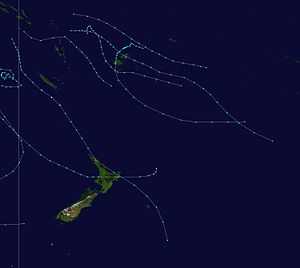1979–80 South Pacific cyclone season
 | |
| Season summary map | |
| First system formed | December 9, 1979 |
|---|---|
| Last system dissipated | April 8, 1980 |
| Strongest storm | – (10-minute sustained) |
| Total depressions | 11 official 2 unofficial |
| Tropical cyclones | 11 |
| Total fatalities | Unknown |
| Total damage | Unknown |
| South Pacific tropical cyclone seasons 1977–78, 1978–79, 1979–80, 1980–81, 1982–83 | |
| Related articles | |
The 1979–80 South Pacific cyclone season saw mostly weak systems.
Storms
Tropical Cyclone Ofa
| Category 2 tropical cyclone (Australian scale) | |||
|---|---|---|---|
| |||
| Duration | 9 December – 15 December | ||
| Peak intensity | 100 km/h (65 mph) (10-min) 980 mbar (hPa) | ||
Ofa was classified on December 9. For several days it slowly deepened and on December 12 attained peak intensity while moving eastward. Three days later Ofa was no more.
Severe Tropical Cyclone Peni
| Category 3 severe tropical cyclone (Australian scale) | |||
|---|---|---|---|
| Category 1 tropical cyclone (SSHWS) | |||
| |||
| Duration | 1 January – 6 January | ||
| Peak intensity | 120 km/h (75 mph) (10-min) 970 mbar (hPa) | ||
Tropical Cyclone Paul
| Category 2 tropical cyclone (Australian scale) | |||
|---|---|---|---|
| Tropical storm (SSHWS) | |||
| |||
| Duration | 2 January – 12 January | ||
| Peak intensity | 110 km/h (70 mph) (10-min) 980 mbar (hPa) | ||
Paul entered the South Pacific on January 7.
Cyclone Rae
Rae lasted five days from February 2 to 7. It remained weak.
Cyclone Ruth
Ruth was a weak Category 1 cyclone.
Cyclone Simon
Simon was of moderate intensity and crossed into the region while weakening. It later struck New Zealand.
Cyclone Sina
Sina became the second consecutive season in a row to strike the nation.
Cyclone Tia
Tia affected Fiji and Tonga.
Cyclone Val
Val stayed at sea.
Tropical Cyclone Wally
| Category 1 tropical cyclone (Australian scale) | |||
|---|---|---|---|
| Tropical storm (SSHWS) | |||
| |||
| Duration | 1 April – 8 April | ||
| Peak intensity | 65 km/h (40 mph) (10-min) 995 mbar (hPa) | ||
Wally lasted in the southern Pacific from April 1 to April 7 and was a category one cyclone on the Australian tropical cyclone intensity scale with a peak pressure of 990 HpA/mbar. During its lifetime it made landfall on the second biggest island of Fiji – Viti Levu.
References
External links
- World Meteorological Organization
- Australian Bureau of Meteorology
- Fiji Meteorological Service
- Meteorological Service of New Zealand
- Joint Typhoon Warning Center


